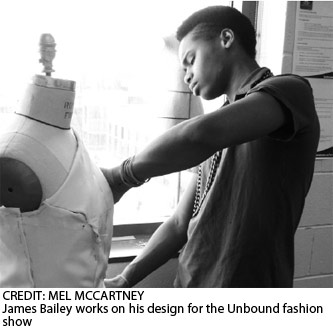Calling all fashionistas!

Every week I think of a topic that will be relevant to you and your fashion life. Whether it's Dior's new designer, fall trends or what perfumes are in season, they're topics that are relevant to your life; they're topics that are applicable to how you live - a student's life.
A student's life — that's a topic. Well, considering this is a fashion article, have you ever stopped to look down at your clothes? Have you ever considered where they're made, how they're made and what needs to be considered when you make them?
You probably haven't, and the reason why I know this is because I never really did either. When I enrolled into the fashion design program at Fanshawe, I had a slight idea of what I was getting myself into. Did I know completely? No.
What I've learned from this first year of school is that the fashion industry is nothing like it seems.
When we watch shows like Fashion Television and RAW, we get an idea of what the "good life" of fashion looks like. Jeanne Beker dressed in high-end clothes attending couture shows. A cute microphone held by a hand decorated with Rolex and diamonds.
Oh, if only.
The clothes on your back are, most likely, made in the least glamorous way possible. No, I won't go into detail of sweatshops and tiny workers stitching on Nike logos. But we simply need to realize that this industry is something so much different than what we have been led to believe. This industry is made up of mathematical equations that determine how we're categorized. We're psychoanalyzed by people who forecast trends they think we'll like in years to come. They classify our behaviours and the way we purchase our clothing and create ideas of what they think we like. Then they take a look at the economy and they spin what we like into what we can afford. Once they create what we can afford, design details are analyzed and deemed popular. These design details are usually determined based upon a mood that these trend-forecasting services see evolving in the world.
After all this work is done approximately two years in advance, companies and brands purchase the rights to this information and create a collection or line based upon what we're supposed to like. This line in itself takes a lot longer than what we ever see. I have learned this through the thirdyear fashion students who are always sleeping in the sewing lab, and have deemed Oasis their new kitchen. The work they create is spectacular.
Whether it be green and purple organza that is essentially death to work with or leather bodices with intricate sewing detailing, they truly show how not only are they designers; they're artists.
Over the past months of this semester, I have had the great privilege of watching these students create their collections. They've done their research and now they're doing their work.
The third-year students' fashion show, Unbound, is without a doubt worth checking out. You will be razzled and dazzled by the beauty of what you see. You will also be amazed to see the details of the garments.
Small stitching, bias bound everything, stitching lines so perfectly spaced they look as if they were done by a machine. These are the things that fashion students have learned to call their craft and I truly feel as though they should be appreciated for all the incredible work I've seen them do.
Unbound takes place at 8 p.m. on April 9 at Museum London. Tickets are $45 and seating is limited. Visit tinyurl.com/fashionunbound for more information or to purchase tickets.













